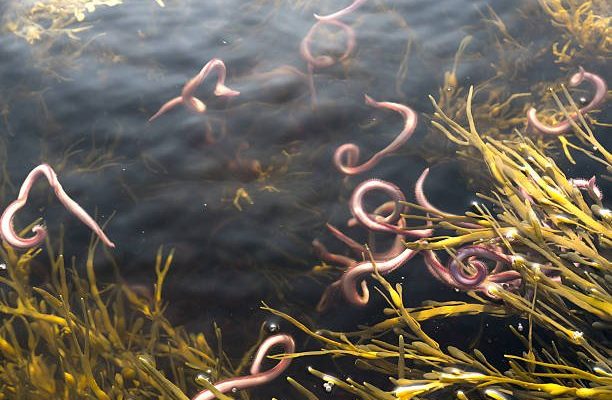
Bloodworms, specifically *Lumbriculus variegatus*, are actually the larval stage of the midge fly. These little red worms are often found in muddy sediments of streams, lakes, and ponds. They are famous among aquarists and fishermen for their vibrant color and nutritional value for fish. But their significance goes far beyond just being fish bait. You might be wondering how such small creatures can impact the environment so greatly. Let’s dive in!
What Are Bloodworms?
Bloodworms are not your average worms. These larvae display a striking reddish color due to high concentrations of hemoglobin, the same protein in our blood that carries oxygen. This unique feature allows them to thrive in low-oxygen environments, like the stagnant waters of marshes and ponds. They grow to be about 3 to 10 centimeters long and live in the sediment, where they feast on decaying plant material and microorganisms.
You might be surprised to learn that bloodworms are highly adaptable. Their presence can indicate the health of an aquatic ecosystem. If you find plenty of bloodworms, it often means the water quality is good enough to support various forms of life. However, if they’re absent, that could be a red flag for environmental issues, like pollution or habitat destruction.
The Role of Bloodworms in Aquatic Ecosystems
In aquatic ecosystems, bloodworms serve multiple essential roles. First and foremost, they act as decomposers. By breaking down organic matter, like dead plants and animals, they recycle nutrients back into the ecosystem. This process is vital; without decomposers like bloodworms, organic materials would pile up, and nutrient cycles would be disrupted.
Furthermore, bloodworms are an important food source for various animals. Fish, birds, and even some mammals actively seek them out. If you were a small fish looking for dinner, bloodworms would probably be one of your top choices. This natural predation creates a healthy food web, ensuring that energy flows efficiently through the ecosystem.
Bloodworms and Soil Health
You might be surprised to learn that bloodworms are not just confined to water. They also play a significant role in soil health. In fact, their relatives—like earthworms—contribute by aerating the soil and promoting good drainage. Bloodworms, while mainly aquatic, contribute to soil through their movement and feeding habits when they are found in wetland soils.
As these worms feast on organic material in the soil, they break it down into smaller particles. This creates humus, a vital component of healthy soil. Humus helps retain moisture and provides nutrients to plants, making it easier for them to grow strong and healthy. You could think of bloodworms as miniature composters working tirelessly beneath our feet!
Bloodworms in Aquaculture
Aquaculture, which is the farming of fish and other aquatic organisms, greatly benefits from bloodworms. They are often used as live feed for young fish and other aquatic species. You can imagine a small fish hatchery where bloodworms are swimming around, providing vital nutrients that help baby fish grow. This practice not only supports the fish’s health but also reduces the need for artificial feeds, which can sometimes contain harmful additives.
Moreover, bloodworms have a high protein content, making them an attractive option for aquaculture operations looking to enhance growth rates. When fish are fed bloodworms, they often display improved survival rates and overall health, leading to a more sustainable and productive aquaculture environment.
Harvesting Bloodworms
You might wonder how bloodworms are harvested. It’s not as simple as just reaching into the water and pulling them out! Typically, fishermen or aquaculturists use special techniques to collect bloodworms. The most common method involves using a sieve or net to gather them from the sediments during low tide in marshy areas.
After they are harvested, bloodworms must be kept in optimal conditions. They thrive in cool, oxygen-rich environments, and without proper care, they can lose their vibrant color and nutritional value. Maintaining the right conditions not only preserves their quality but also ensures that they remain a valuable resource for both aquarists and the ecosystem at large.
Environmental Concerns
While bloodworms are beneficial, it’s essential to consider their habitats. Pollution and habitat destruction can negatively impact their populations and the ecosystems they support. For instance, water polluted with heavy metals can harm bloodworms and the countless species that rely on them for food.
Here’s the thing: protecting wetlands and waterways is crucial not just for bloodworms but for the entire food web. If you’re passionate about environmental protection, consider getting involved in local conservation efforts. Every action counts when it comes to preserving these vital habitats!
Bloodworms might not be the most glamorous creatures in nature, but their role in soil and aquatic ecosystems is truly invaluable. From recycling nutrients in the soil to serving as essential food sources in aquatic food webs, these little red worms have a big impact.
As you explore the outdoors, take a moment to appreciate the unseen wonders like bloodworms that contribute to the health of our planet. They remind us of the intricate connections in nature, where even the smallest creatures play a part. So, whether you’re an aspiring aquarist or just curious about the natural world, remember to look closer. You might just discover a world of tiny heroes working hard to keep our ecosystems thriving.

